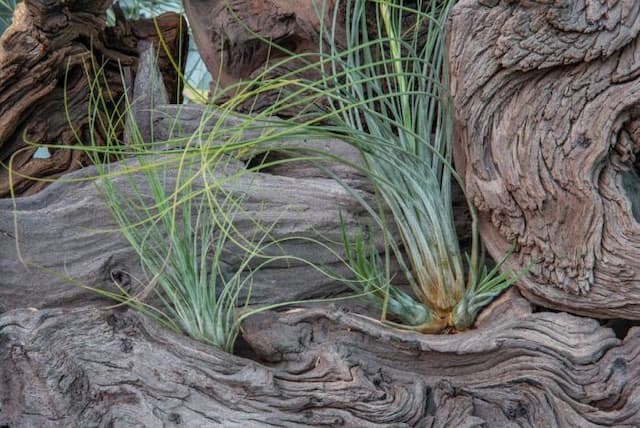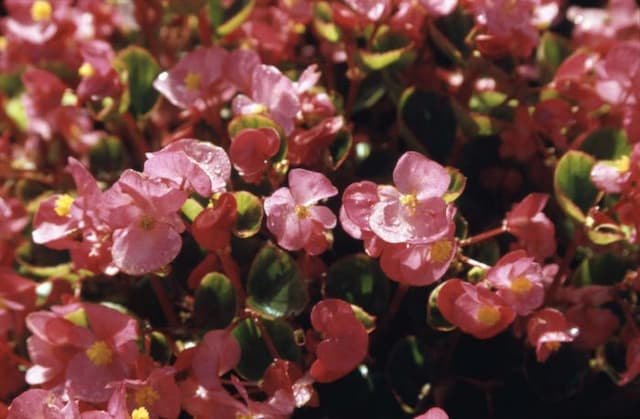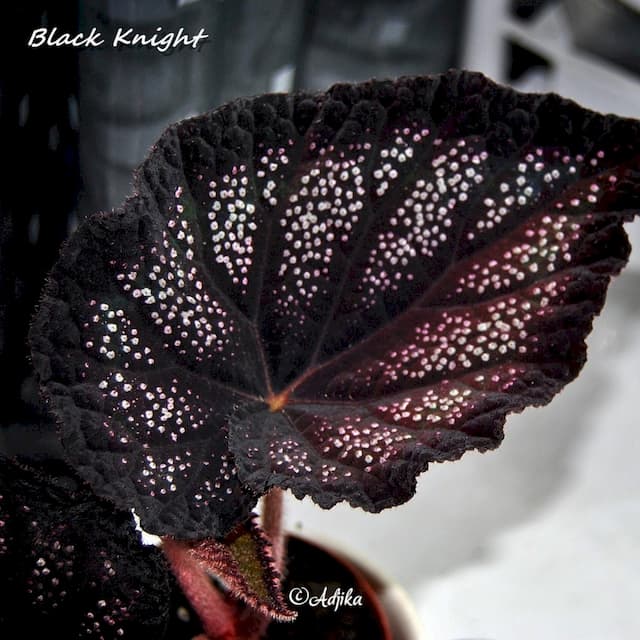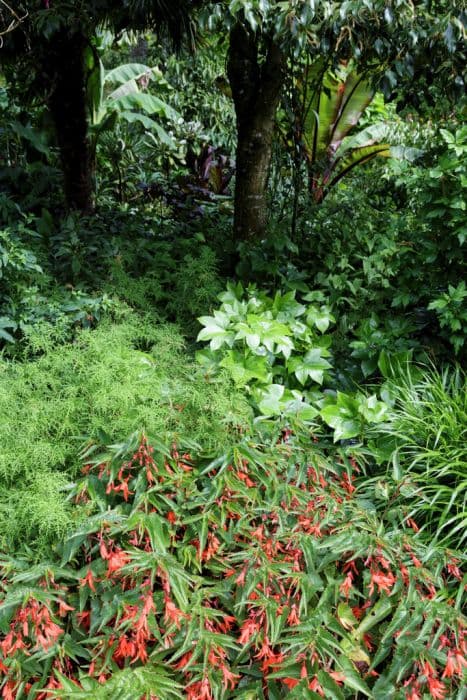Wax Begonia Begonia Semperflorens Cultorum Group (S)

ABOUT
The Begonia Semperflorens Cultorum Group, commonly known as wax begonia, is a popular ornamental plant with a lush, bushy appearance. It showcases fibrous roots with fleshy, rounded to ovate leaves that may have a waxy sheen, giving them a glossy texture. These leaves are either bright green or bronze in color, depending on the variety. Wax begonias produce clusters of small, delicate flowers that can be found in a range of colors, including white, pink, red, and bicolor variations. The flowers bloom with a symmetrical form, often displaying a contrasting yellow center and are continuous bloomers, hence "semperflorens" meaning "always flowering." Overall, the wax begonia is known for its dense foliage and profusion of blooms, creating a vibrant display of color. The plant is appreciated for both its ornamental leaves and its bright flowers, which together provide a continuous show of color throughout the growing season.
About this plant
 Names
NamesFamily
Begoniaceae.
Synonyms
Wax Begonia, Bedding Begonia, Semperflorens, Perennial Begonia, Everblooming Begonia, Ever-flowering Begonia, Friendship Plant.
Common names
Begonia Semperflorens.
 Toxicity
ToxicityTo humans
Wax Begonia is generally considered non-toxic to humans. However, eating large amounts of the plant can potentially cause stomach upset, including nausea and vomiting. It's advisable to avoid ingestion and to keep the plant out of reach of young children who might inadvertently consume plant material.
To pets
Wax Begonia is known to be toxic to pets, especially cats and dogs. If ingested, it can lead to symptoms including vomiting, salivation, and kidney failure in severe cases. It's important for pet owners to keep Wax Begonias out of reach to prevent accidental ingestion and potential poisoning. If you suspect your pet has ingested this plant, consult a veterinarian immediately.
 Characteristics
CharacteristicsLife cycle
Annuals
Foliage type
Evergreen
Color of leaves
Varies
Flower color
Varies
Height
6-12 inches (15-30 cm)
Spread
6-18 inches (15-45 cm)
Plant type
Herb
Hardiness zones
10
Native area
Brazil
Benefits
 General Benefits
General Benefits- Easy to Grow: The Begonia Semperflorens is known for being low-maintenance, making it an excellent choice for beginner gardeners.
- Long Blooming Season: It offers a continuous display of flowers from spring until frost, providing long-lasting color to gardens and landscapes.
- Variety of Colors: Available in a range of colors including red, pink, white, and bicolors, which allows for creative garden design.
- Shade Tolerance: It performs well in shaded areas where many other blooming plants may struggle, making it ideal for shaded gardens.
- Drought Resistance: Once established, these begonias can withstand periods of drought, reducing the need for frequent watering.
- Edging Plant: Begonia Semperflorens is suitable for use as a border or edging plant due to its uniform growth and neat appearance.
- Container Gardening: It is well-suited for pots, window boxes, and hanging baskets, offering versatility in landscaping and urban gardening.
- Seasonal Groundcover: Its dense foliage can serve as a temporary groundcover, filling spaces quickly and adding a carpet of color.
- Attracts Pollinators: While it's not the biggest attractor, it can still draw beneficial insects like butterflies to the garden.
- Deer Resistance: These begonias are less likely to be eaten by deer, making them suitable for gardens in areas with high deer populations.
 Medical Properties
Medical Properties- This plant is not used for medical purposes.
 Air-purifying Qualities
Air-purifying QualitiesThis plant is not specifically known for air purifying qualities.
 Other Uses
Other Uses- Edging for pathways: Wax begonias can be planted alongside garden paths to create visually appealing borders due to their consistent and colorful foliage.
- Container gardening: These plants are well-suited for pots and hanging baskets, providing a decorative element in balconies and patios.
- Ground cover: Because they are low-growing and spread easily, wax begonias can be utilized to cover bare spots in the garden, helping maintain soil moisture and prevent weeds.
- Floral crafts: The colorful flowers of wax begonias can be used in making natural jewelry like earrings or pendants when dried and preserved in resin.
- Culinary garnish: The flowers of wax begonias are edible and can be used as a vibrant and attractive garnish for salads and desserts.
- Photography subject: Due to their bright and varied colors, wax begonias make excellent subjects for macro photography and garden portfolios.
- Companion planting: Wax begonias can be inter-planted with vegetables and other flowers to create a diverse and healthy garden ecosystem.
- Wedding decorations: The flowers and leaves of wax begonias can be used as part of natural, biodegradable confetti or table decorations at weddings.
- Seasonal indoor decor: Wax begonias can be brought indoors to add a splash of color to interior spaces during the winter months.
- Fairy gardens: These small-sized plants are ideal for use in whimsical fairy garden designs, for both indoor and outdoor miniature landscapes.
Interesting Facts
 Feng Shui
Feng ShuiThe Wax Begonia is not used in Feng Shui practice.
 Zodiac Sign Compitability
Zodiac Sign CompitabilityThe Wax Begonia is not used in astrology practice.
 Plant Symbolism
Plant Symbolism- Caution: Begonias can symbolize a sense of caution or warning. When given as a gift, it might be a subtle reminder to the recipient to be wary or watchful about a situation.
- Harmony: The Begonia's balanced and symmetrical shape can convey a message of harmony and peace.
- Uniqueness: With numerous varieties and vibrant colors, begonias can represent individuality and uniqueness.
- Gratitude: In some cultures, giving begonias expresses appreciation or gratitude for someone's kindness.
- Deep thoughts: Being contemplative plants, begonias can indicate deep thought or introspection.
 Water
WaterWax Begonias should be watered thoroughly, allowing the top inch of soil to dry out between waterings. Overwatering can lead to root rot, so it is vital to ensure that the soil is moist but not soggy. In general, aim to water wax begonias once every week, but this can vary depending on the humidity and temperature. During particularly hot or dry periods, more frequent watering may be necessary, potentially every 3-4 days. It is best to use lukewarm water, and when watering, provide enough water so that it runs out of the drainage holes, indicating that the soil is fully saturated.
 Light
LightWax Begonias prefer bright, indirect light and can thrive under partial shade. An ideal spot would be a location where they receive morning sunlight but are protected from the harsh afternoon sun. Placing them near an east-facing window or a lightly shaded southern window can provide the optimal light conditions they need to flourish without the risk of leaf burn from direct sunlight.
 Temperature
TemperatureWax Begonias do best in temperatures ranging from about 60 to 75 degrees Fahrenheit. They can tolerate minimum temperatures of no lower than 50 degrees Fahrenheit and maximum temperatures up to about 86 degrees Fahrenheit. However, consistent temperatures within the ideal range will promote vigorous growth and flowering.
 Pruning
PruningWax Begonias should be pruned to remove dead or dying leaves and flowers, which encourages new growth and maintains a compact, bushy shape. Pruning is best done in the spring or as needed throughout the growing season. Pinch off the tips of leggy stems to promote branching, and trim any overly long or damaged stems to keep the plant looking tidy.
 Cleaning
CleaningAs needed
 Soil
SoilWax Begonias prefer well-draining soil with a mix of peat, compost or rotted manure, and perlite or sand. The ideal soil pH for Wax Begonias is slightly acidic to neutral, ranging from 5.5 to 6.5 for optimal growth.
 Repotting
RepottingWax Begonias should be repotted every 1-2 years or when they become root-bound. Use fresh potting mix and a slightly larger pot to encourage continued growth.
 Humidity & Misting
Humidity & MistingWax Begonias thrive in moderate to high humidity levels, ideally between 50% to 70%. They do not tolerate dry air well, so maintaining a humid environment is crucial for their health.
 Suitable locations
Suitable locationsIndoor
Place Wax Begonias in bright, indirect light and ensure high humidity.
Outdoor
Plant in partial shade, sheltered from intense afternoon sun.
Hardiness zone
10-11 USDA
 Life cycle
Life cycleThe life of the Begonia Semperflorens, commonly known as Wax Begonia, begins with seed germination, which requires warmth and light to initiate. After germination, seedlings develop their first true leaves and gradually become young plants, needing high humidity and adequate light conditions. As they mature, Wax Begonias form a bushy growth with fleshy, succulent stems and glossy, rounded leaves, often coming in shades of green or bronze. Throughout spring and summer, they produce continuous clusters of small, delicate flowers, which can be red, white, pink, or bicolor, attracting pollinators. After flowering, seed formation occurs, with the plant setting seeds that can be collected for propagation or allowed to self-sow. In regions with cold winters, Wax Begonias are treated as annuals and die after the first frost, but if conditions allow, they can behave as perennials, dying back to the ground and reemerging in the spring.
 Propogation
PropogationPropogation time
Spring-Early Summer
Propogation: Wax begonia (Begonia Semperflorens Cultorum Group) is often propagated through stem cuttings, which is the most popular method due to its simplicity and effectiveness. To propagate by stem cuttings, a healthy stem section is cut just below a node, generally a few inches long, using a clean, sharp pair of scissors or a knife. The cut end of the stem is then dipped in rooting hormone to encourage root growth and planted in a well-draining soil mix. The pot is then kept in a warm area with indirect light and the soil is kept moist but not waterlogged. Roots typically develop within a few weeks, after which the new plant can be gradually acclimatized to normal conditions and eventually repotted as needed.

![Begonia [Allure]](/_next/image?url=https%3A%2F%2Fplants-admin.emdemapps.com%2Fimages%2Fplants%2F%2Fimages%2F604b5b9006ab9.png&w=640&q=75)







